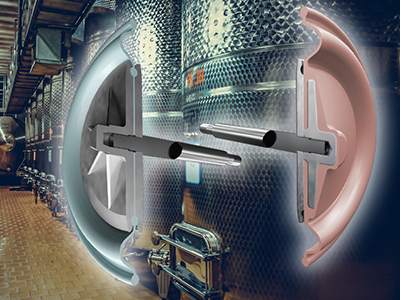
AODD Tech: Diaphragm material alternatives to Buna in industrial applications
Mike Edwards
Features air-operated double-diaphragm AODD pumps Wilden The Integral Piston Diaphragm (IPD) design of the Chem-Fuse diaphragm (right) encases the shaft connection within the diaphragm material. This eliminates notorious wear and product-trap areas that are inherent in traditional diaphragm design (left), as well as the outer piston and its attendant abrasive wear during normal operation. The result is a diaphragm that is longer lived, safer and more leak-resistant, which is a critical need when handling dangerous or hazardous non-food-grade oils, abrasives, and solvents.
The Integral Piston Diaphragm (IPD) design of the Chem-Fuse diaphragm (right) encases the shaft connection within the diaphragm material. This eliminates notorious wear and product-trap areas that are inherent in traditional diaphragm design (left), as well as the outer piston and its attendant abrasive wear during normal operation. The result is a diaphragm that is longer lived, safer and more leak-resistant, which is a critical need when handling dangerous or hazardous non-food-grade oils, abrasives, and solvents. The air-operated double-diaphragm (AODD) pump has been a godsend for operators in the industrial space who need a cost-effective, reliable, and safe pump technology for a wide range of liquid-transfer processes. These processes can include such rough-and-tumble utilitarian applications as those found in the mining, water/wastewater, and oil and gas industries, as well as those hygienic food and beverage, pharmaceutical and cosmetic operations that require a bit more finesse.
No matter the application, though, the facility operator must take care to choose AODD pump configurations that feature high-performance, long-lasting diaphragms.
Early AODD pump models — the technology has been available since 1955, or for more than 65 years — were outfitted with simple, fabric reinforced rubber diaphragms. While these rubber diaphragms have performed admirably over these many years, they have a couple of drawbacks: they must be reinforced with a stronger material, and they must be supported by inner and outer plates in operation.
Some other shortcomings of synthetic rubber diaphragm models are poor abrasion resistance and, except in the higher end of the synthetic rubber spectrum, limited temperature ranges. These can limit the application range, and shorten the diaphragm’s effective service life, leading to increased maintenance, repair, and replacement costs, along with the cost of cleanup and remediation should a pump develop a catastrophic leak because of a failed diaphragm.
There have been some notable advances in diaphragm design and the materials used to construct them over the years, and the manufacturers of diaphragms are always looking for ways to improve their products. This white paper will illustrate how the latest advance in diaphragm technology and the introduction of the Saniflex (Hytrel) model is well on its way to setting a new standard in diaphragm performance and reliability, especially in applications typically handled with Buna.
Continue reading this white paper by Rob Jack and Tom Zuckett from Wilden.
Print this page